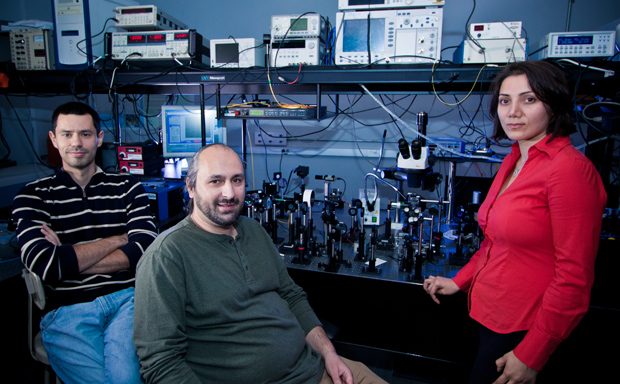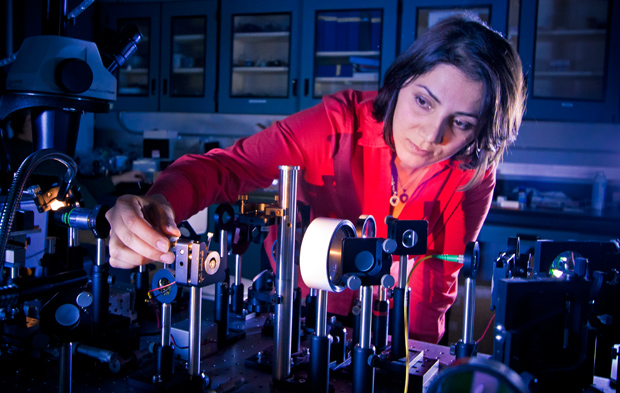Electrical Engineers Build “No-Waste” Laser
Team makes startling discovery in highly efficient, “thresholdless” laser
By:
- Becky Ham
Published Date
By:
- Becky Ham
Share This:
Article Content

L-R Michael Kats, Aleksandar Simic and Mercedeh Khajavikhan take a break in the optics laboratory.
A team of University of California, San Diego researchers has built the smallest room-temperature nanolaser to date, as well as an even more startling device: a highly efficient, “thresholdless” laser that funnels all its photons into lasing, without any waste.
The two new lasers require very low power to operate, an important breakthrough since lasers usually require greater and greater “pump power” to begin lasing as they shrink to nano sizes. The small size and extremely low power of these nanolasers could make them very useful components for future optical circuits packed on to tiny computer chips, Mercedeh Khajavikhan and her UC San Diego Jacobs School of Engineering colleagues report in the Feb. 9 issue of the journal Nature.
They suggest that the thresholdless laser may also help researchers as they develop new metamaterials, artificially structured materials that are already being studied for applications from super-lenses that can be used to see individual viruses or DNA molecules to “cloaking” devices that bend light around an object to make it appear invisible.
All lasers require a certain amount of “pump power” from an outside source to begin emitting a coherent beam of light or “lasing,” explained Yeshaiahu (Shaya) Fainman, a professor in the Department of Electrical and Computer Engineering at UC San Diego and co-author of the new study. A laser’s threshold is the point where this coherent output is greater than any spontaneous emission produced.
The smaller a laser is, the greater the pump power needed to reach the point of lasing. To overcome this problem, the UC San Diego researchers developed a design for the new lasers that uses quantum electrodynamic effects in coaxial nanocavities to alleviate the threshold constraint. Like a coaxial cable hooked up to a television (only at a much smaller scale), the laser cavity consists of a metal rod enclosed by a ring of metal-coated, quantum wells of semiconductor material. Khajavikhan and the rest of the team built the thresholdless laser by modifying the geometry of this cavity.

Mercedeh Khajavikhan in the lab.
The new design also allowed them to build the smallest room-temperature, continuous wave laser to date. The new room-temperature nanoscale coaxial laser is more than an order of magnitude smaller than their previous record smallest nanolaser published in Nature Photonics less than two years ago. The whole device is almost half a micron in diameter – by comparison, the period at the end of this sentence is nearly 600 microns wide.
These highly efficient lasers would be useful in augmenting future computing chips with optical communications, where the lasers are used to establish communication links between distant points on the chip. Only a small amount of pump power would be required to reach lasing, reducing the number of photons needed to transmit information, said Fainman.
The nanolaser designs appear to be scalable – meaning that they could be shrunk to even smaller sizes – an extremely important feature that makes it possible to harvest laser light from even smaller nanoscale structures, the researchers note. This feature eventually could make them useful for creating and analyzing metamaterials with structures smaller than the wavelength of light currently emitted by the lasers.
Fainman said other applications for the new lasers could include tiny biochemical sensors or high-resolution displays, but the researchers are still working out the theory behind how these tiny lasers operate. They would also like to find a way to pump the lasers electrically instead of optically.
Co-authors for the Nature study, “Thresholdless Nanoscale Coaxial Lasers,” include Mercedeh Khajavikhan, Aleksandar Simic, Michael Kats, Jin Hyoung Lee, Boris Slutsky, Amit Mizrahi, Vitaliy Lomakin, and Yeshaiahu Fainman in the Department of Electrical and Computer Engineering at the UC San Diego Jacobs School of Engineering. The nanolasers are fabricated at the university’s NANO3 facility. The research was funded by the Defense Advanced Research Projects Agency, the National Science Foundation, the NSF Center for Integrated Access Networks (CIAN), the Cymer Corporation and the U.S. Army Research Office.
Share This:
You May Also Like
Stay in the Know
Keep up with all the latest from UC San Diego. Subscribe to the newsletter today.



